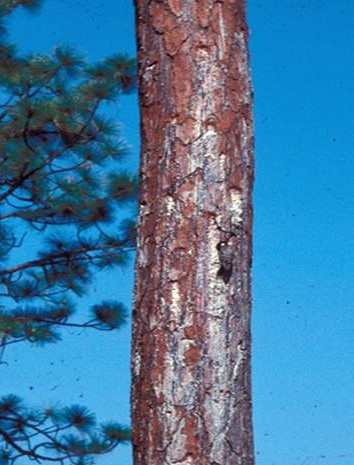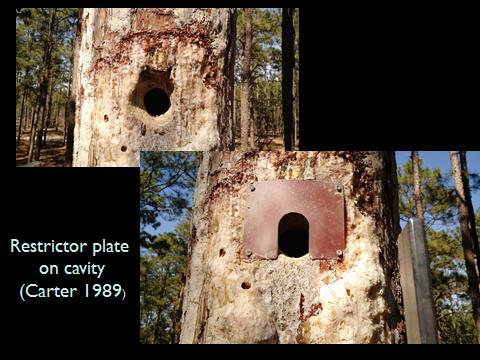In the early years of the Sandhills RCW project, research focused on the species’ cooperative breeding system. This work suggested that the unique cavities that RCWs construct in live pines were the key to the evolution of their breeding system and to population dynamics. To test this idea a drilling technique for constructing artificial cavities was developed (Copeyon 1990) and the first artificial RCW cavities were constructed at 20 sites in the Sandhills in the late 1980s. These “recruitment clusters” resulted in the formation of new RCW groups (Copeyon et al. 1991; Walters et al. 1992) and thus a management technique to stimulate population growth was born.
One of the first drilled artificial cavities provisioned and used for roosting by RCWs, Circa 1988.
Artificial cavity installation is one means to enhance RCW roosting and nesting habitat, while another method involves modification of enlarged, suitable cavities with restrictor plates.
ARTIFICIAL CAVITIES
Drilled cavities and start cavities (Copeyon 1990)
Insert cavities (Allen 1991)
RESTRICTOR PLATES
Restrictors were developed by Dr. Jay Carter in response to depredation of RCW eggs and nestlings by larger species of woodpeckers or European starlings; these species would then use the RCW cavities to raise their own young. The absence of snags (dead standing trees) in developed areas of the NC Sandhills appears to exacerbate this competition for nest sites. Restrictor plates allow RCWs to reclaim enlarged, otherwise suitable roost and nest cavities while discouraging usurpation by these more aggressive species.
SEI has provided significant financial assistance and oversight for cavity management within RCW clusters found on private lands and for newly established recruitment clusters. SEI has facilitated construction of ~ 200 cavities while coordinating with local landowners. Many clusters occur on Safe Harbor properties. Approximately 60 restrictor plates have been installed and monitored by SEI biologists.
Fort Bragg Endangered Species Branch and North Carolina Wildlife Resources Commission biologists oversee RCW cavity management throughout Fort Bragg and the Sandhills Game Land, respectively.


